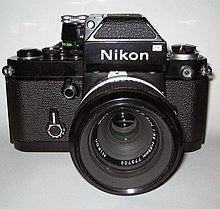Nikon F series

The Nikon F3 (here with the glasses-friendly HP viewfinder) was the successor to the F2. Initially viewed critically because of the electronic control, it was able to convince with its reliability. It was on the market from 1980 to 2002, making it one of the longest-running professional cameras ever.
The F series from Nikon is a range of 35mm camera housings that are designed for the requirements of professional photographers. The manufacturer named such cameras with an F followed by a single-digit number.
There are also other cameras from Nikon with the F in their name, but they cannot be assigned to this professional series: Nikkorex F , Nikkormat FT / FS / FTN / FT2 / FT3, the FE series , the FM series , FG , FG -20 , F-301 , F-401 , F-501 , F-601M , F-601 , F-801 , F-801s , F50 , F55 , F60 , F65 , F70 , F75 , F80 , F90 , F90x , F100 .
In analogy to the F series , Nikon offers its digital SLR cameras of the D series .
Series
- 1959: Nikon F , the company's first SLR camera . It is purely mechanical and has either a prism viewfinder (without exposure meter) or an optional photomic viewfinder as exposure meter.
- 1971: Nikon F2 , a technically very similar successor that marked the worldwide breakthrough in the professional field. The viewfinder and ground glass are compatible with the Nikon F. One of the most important innovations was the foldable rear wall, which made it easier to change the film and made it possible to connect a motor with the film inserted.
- 1980: Nikon F3 , this camera introduces an electronically controlled shutter, aperture priority and TTL automatic flash into the series. Although many professionals were initially skeptical about electronics, it was still convincing, and the F3 also made its name as a robust and reliable professional camera with a "timeless" design. Apart from the lenses, the system accessories are no longer compatible with the F or F2.
- 1988: Nikon F4 , the F4 for the first time in this series has autofocus and automatic film transport integrated into the housing . For the first time, Nikon also offers spot exposure metering. Various exchangeable battery parts allow frame rates of up to 5.7 frames / s. Apart from the lenses, their system accessories are also not compatible with their predecessors.
- 1996: Nikon F5 , this camera expands the autofocus technology with several measuring fields and has a permanently integrated portrait format handle with a powerful battery pack. The maximum frame rate is a sensational 8 frames / s.
- 2004: Nikon F6 , the camera appears despite the increasing digitization of the professional sector. The autofocus has been revised again (now with 11 measuring fields, taken from the Nikon D2H ), but the camera now has a smaller housing with an optional portrait handle. For the first time, however, the interchangeable viewfinder has been dispensed with, which was a typical feature of the professional camera in the Nikon F series.
Individual evidence
- ^ Peter Braczko, Nikon Fascination, History - Technology - Myth from 1917 to the present day , Rita Wittig Fachbuchverlag, Hückelhoven 1992, ISBN 3-88984-047-7 .
- ^ Peter Braczko, Nikon Pocket Book , Rita Wittig Fachbuchverlag, Hückelhoven 1994, ISBN 3-88984-133-3 .
